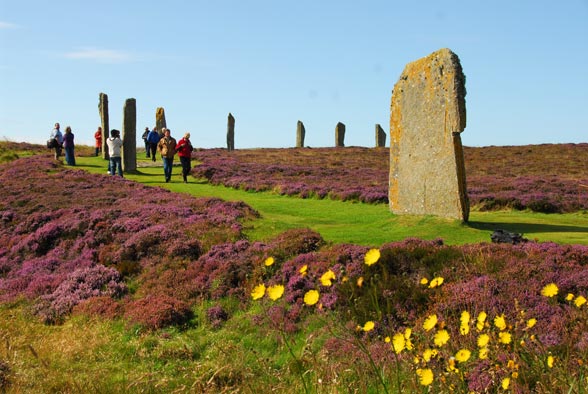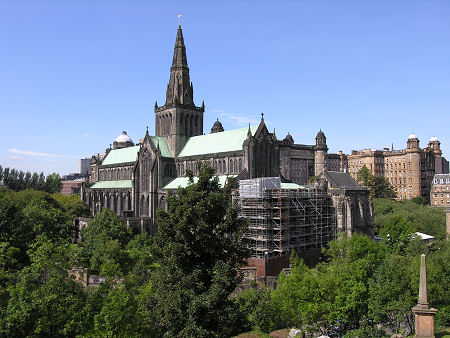

Landscapes as awe-inspiring as the cities are sophisticated. Scotland has a long turbulent history, and its castles and cathedrals carry memory in every stone. The capital city Edinburgh has a medieval feel and an unbeatable festival. Glasgow has red stone, art noveau chic and ebullient people. Spectacular islands, beaches and Highlands complete the picture.
Take the high road or the low road - just get there. Honed by long competition with its English neighbours, buoyant Scotland has survived encroachment, brass-monkey weather and invasion by stand-up comedians. Its people are feisty, opinionated and fiercely loyal. The countryside is a wild, beautiful tumble of raw mountain peaks and deep glassy lakes.


Scotland is about half the size of England, and roughly two-thirds of the country is mountain and moorland. Geographically, it can be divided into three areas: the Southern Uplands, Central Lowlands, and Northern Highlands and Islands. The Southern Uplands are the fertile plains and hills bordering England; the Central Lowlands run from Edinburgh to Glasgow and contain the industrial belt and most of the population, while the Highlands are mountain ranges of sandstone and granite, rising to their heights at Ben Nevis, Britain's highest mountain. Of Scotland's 790 islands, 130 are inhabited. Island groups include the Inner and Outer Hebrides, the Orkneys and Shetlands.

Capital: Edinburgh
Queen: Elizabeth II
Prime Minister: Gordon Brown
First Minister: Alex Salmond
Time zone: GMT 0
Area: 78772
Population: 5160000
People: Celts, Anglo-Saxons
Currency: Pound Sterling ( £ )
GDP: Approx. £ 194000000000
Major industries: Banking and finance, steel, transport equipment, oil and gas, whisky, tourism
Major Trading Partners: EU & USA
Daylight Saving: From last Sunday in March to last Sunday in October
Country Dialing Code: 44
Languages: Until the 12th or 13th century, Gaelic was spoken in all of Scotland, although Lallans (an English dialect with French and Scandinavian influences) has been spoken in the Lowlands for centuries. Now only about 66,000 people speak Gaelic, mainly in the Hebrides and northwest Scotland. Efforts are being made to halt its decline, and there are numerous Gaelic words that linger in everyday speech and make Scottish English almost impenetrable to foreigners.
The two largest religious denominations are the Presbyterian Church of Scotland (47%) and the Roman Catholic Church (16%), with 28% claiming no religious affiliation at all. Non-Christian religions account for only 2% of the population, mostly small communities of Muslims, Hindus, Sikhs and Jews.

There are direct air services from Europe to Edinburgh, Glasgow, Dundee, Aberdeen, Inverness or Kirkwall, and from the States to Glasgow or Edinburgh.Long-distance buses are the cheapest way of getting to Scotland; alternatively you can take a train from London which will get you into Edinburgh in four hours and Glasgow in five - it's comfy but it's not cheap.Coming from Ireland, you also have the option of taking a ferry. In summer there is a weekly ferry between Aberdeen, the Shetlands and Norway, and a twice-weekly ferry from Aberdeen to the Faroes.For those with their own transport, main roads are busy but flow quite well - a drive from London to Edinburgh will take about eight hours.

There are domestic flights within Scotland, but it's hardly worth the price unless there's no other option. Buses are thick on the ground.Scotland's train routes are picturesque but somewhat limited and expensive. Driving around Scotland is generally easy and far less busy than in England, although petrol stations may be few and far between (as well as pricey).If you want to hit the water, boats run to most of the islands or you can get a ferry from Aberdeen to Orkney or Shetland.

'Varied' describes Scotland's climate perfectly. There are wide variations in climate over small distances, and a sunny day will often as not be followed by a rainy one. Although the country nudges the Arctic Circle, the Gulf Stream winds keep the temperature mild (well, relatively mild). The Highlands, however, can have extreme weather at any time. The east coast tends to be cool and dry, with winter temperatures rarely dropping below freezing (but watch out for the bone-chilling winds off the North Sea). The west coast is milder and wetter, with average summer highs of 19° C (66° F). May and June are the driest months; July and August the warmest. In the north the summer sun barely sets; the winter sun barely rises.

your blog describe a logical view of the things. It is very effective for the reader. Please post more blog related to this.
ReplyDeleteVisit :- Scottish travel